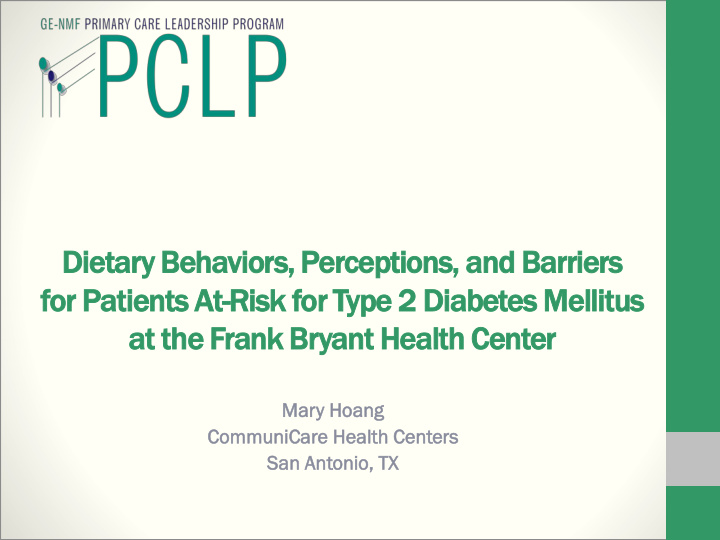



Dietary Behaviors, Perceptions, and Barriers for Patients At At-Risk for Type 2 Diabetes Mellitus at the Frank Bry ryant Health Center Mary Hoang ang Comm mmuni niCare Care Health th Centers San An Antoni onio, o, TX
Introduction • 14% of San Antonio’s population is diabetic • Ethnicity plays a role: Hispanics and African-Americans are 2x more likely to develop Type 2 Diabetes Mellitus (T2DM) than Caucasians • What other factors contribute to the development of T2DM? • Diet et and Physical Activity
Background • Lack of Avail ilab ability ility of healthy foods in low-income neighborhoods • High Cost of healthy foods • Unhealthy Social al Environment nment • unhealthy dietary behavior of friends and family members • household taste preferences • Difficulty in food Prepar aration ation • lack of time • lack of skill
Methodology • Survey instrument • Free response • Yes or No questions • Likert scale questions • Timeline • Week 1: background research and survey creation • Weeks 2 & 3: survey collection • Weeks 4 through 6: data analysis and completion of paper • Surveys collected: 44 • Population • Adult patients at the primary care clinics at the Frank Bryant Health Center • Stratified into at-risk for T2DM and non at-risk for T2DM • At-risk: history of gestational diabetes or family history of diabetes
Results Demograph aphics ics • 36% men, 64% women • average age: 45 • 47% Hispanic, 41% African-American, 7% Caucasian, 5% Asian • 58% obese, 26% overweight, 14% normal, 2% underweight Di Diabet etes History • 75% at-risk for T2DM, 25% non at-risk for T2DM % Patients Who Received Diabetes Education Please rate your At-Risk Non At-Risk 100 understanding of (n = 32) (n = 10) 80 diabetes. 60 Percent Good 28% 50% 45 43 36 40 Fair 63% 30% 20 Poor 9% 20% 0 Total At-Risk Non At-Risk
Results, continued External Barriers Statement At-Risk Non At-Risk “Yes” Responses “Yes” Responses 2: There are enough healthy food 88% 100% options where I live. 3: Healthy food is too expensive. 58% 18% 4: Healthy food is hard to prepare. 27% 0% 5: My family and friends usually eat 36% 36% healthy food. 8: I have a support system to help 58% 55% me eat healthier. Values Questions At-Risk Non At-Risk Majority responses Majority responses 9: How important is it for me to eat 5 5 healthy? (1=not, 5=very) (91%) (73%) 10: How important is it for me to 5 4 eat on a budget? (1=not, 5=very) (58%) (55%)
Results, continued Self-Perception Statements At-Risk Non At-Risk “Yes” Responses “Yes” Responses 1: I believe that I eat healthy. 58% 73% 6: I am afraid my current diet will 45% 36% increase my risk for diabetes. 7: I am actively trying to eat 88% 82% healthier. Of those who said they ate healthy: • 56% did not include fresh fruit as part of their typical daily diet • 22% did not include at least one full serving of vegetables as part of their typical daily diet
Discussion • Significant portion of CommuniCare patients are overweight or obese, yet only 54-68% have a weight goal • At-risk group not receiving adequate diabetes education from primary care provider • Greatest external barriers for at-risk group: • high cost of healthy food • difficulty in healthy food preparat ation ion • Greatest (unseen) external barrier for both groups: • socia ial envir ironme nment nt: unhealthy dietary behaviors and preferences in friends and family members • Patient health literacy seems lacking, especially because many patients who believe they eat healthy are lacking in daily fruit and vegetable intake
Recommendations • Emphasis on weight loss: set a specific weight loss goal for overweight/obese patients • Proper nutrition education, especially for patients at-risk for T2DM • Involve friends and family members in changing their eating habits as well • Train youth to eat fruits and vegetables • Partner with Texas Diabetes Institute to provide more cooking classes that teach culturally-relevant and inexpensive food preparation • Partner with local diabetes prevention programs to create more widespread attention to, and practice of, healthier lifestyle choices
Conclusion • Focus on improving patient health literacy • Barriers exist: cost is possibly the greatest • Promote healthy lifestyle behavior in a broader context: involve schools, workplaces, churches, etc. • Directions for Future Research: • Which factor is the greatest barrier to healthy eating? • Patients potentially live in a food desert, but do not have the health literacy to understand this Ask about external barriers in a different way • Internal barriers: cultural and taste preference considerations, current eating habits, personality types
Recommend
More recommend